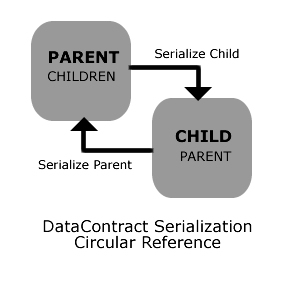 Cyclic Reference
Cyclic Reference
As a WCF Developer you've no doubt run into some issues with object serialization at some point or another during the course of developing your applications. Either during the course of pushing your entities through a WCF Service or by attempting to serialize those object for transit through other media. Recently I ran into some issues around serializing WCF Entities with Circular References (or cyclic relationships) between parent & child Objects.
Background
A large percentage of our company's software work relies on moving a variety of object graphs around through WCF. These object graphs, often times contain self-references or circular references. The data we deal with is primarily related to the airline industry; specifically crew & flight schedules. It contains complicated tree structures of data with information on the flights crew-member's fly, the duties (work-shifts) those flights belong to & the pairings, those duties are contained within. (A pairing is airline industry parlance for a collection of Duties organised into a longer 4 or 5 scheduled body of work for a crew member. Confusingly, it is not necessarily a Pair of anything).
In order to allow us to more easily navigate these object graphs, we populate a number of helper properties on the entities to allow us to traverse up and down the graph with ease. The following is an extremely simplified example of what gets populated in our Crew Schedule "Roster" Object Graph and shows the relations ships between the three previously mentioned domain entities.
Of course, this makes for some interesting cyclic situations when both the parent objects & contents of the child collections are cross-wired to one another and we want to serialize those objects for use through a WCF Service.
 Visual Studio 2012
Visual Studio 2012 VS2012 Dark Color Theme
VS2012 Dark Color Theme Windows 8 & TrueCrypt Security
Windows 8 & TrueCrypt Security Over the past few weeks I've been working on a new project in our company which involved building a number of inter-dependent assemblies, "strongly naming" them and installing them into the Global Assembly Cache. Over the course of the project, I was forced to look at a number of issues related to assembly versions, solution organisation and the deployment of assesmblies in a developer environment.
Over the past few weeks I've been working on a new project in our company which involved building a number of inter-dependent assemblies, "strongly naming" them and installing them into the Global Assembly Cache. Over the course of the project, I was forced to look at a number of issues related to assembly versions, solution organisation and the deployment of assesmblies in a developer environment.